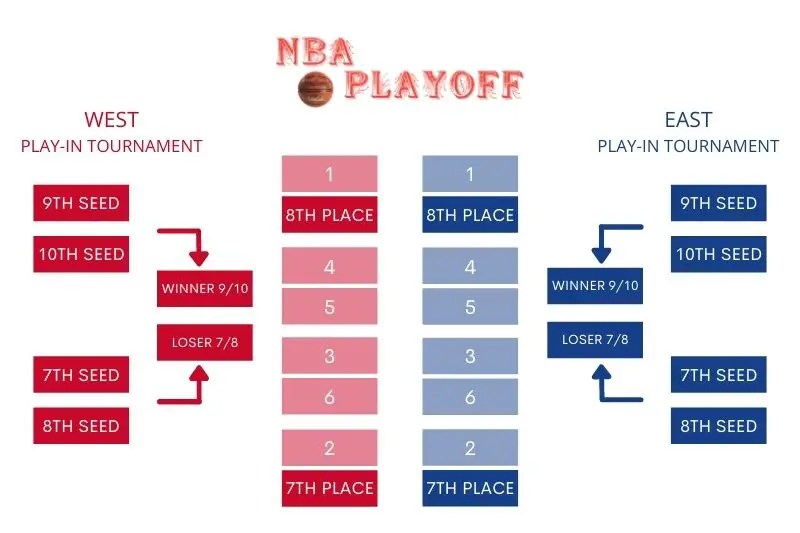Basketball is a sport with its own language; it has a whole distinct library of basketball-specific terms, and for those new to the game, it can be difficult to keep up with the vocabulary.
This article strives to be part of solving that wider problem, by specifically delving into what the term “seed” means in basketball, as well as showing how it’s used at the collegiate and highest professional levels.
So, what exactly is seeding?
A “seed” in basketball is the number that correlates to a team’s placement within its league. It works as a ranking system that’s designed to designate how well team’s performed throughout the regular season, as well as dictate the post season drawing for teams that make it to the playoffs.
It’s important to note at this point that the National Collegiate Athletic Association (NCAA) and the National Basketball Association (NBA) seeding systems are not the same.
Yet, in both leagues, you want to be the lowest seed possible (i.e. the 1st seed), and each seed number is given to multiple clubs in preparation for the league’s postseason.
Read on for further details.
Why is it called a seed?
The term “seed” was first used to establish a metaphorical analogy to planting, where one makes an investment and the seed may blossom into a high rank at the end of the tournament or may wither away.
It was intended to test stronger teams against weaker ones.

Since then, the term seed has been used in sports other than tennis, such as American football, ice hockey, and basketball.
Seeds will be given a preliminary ranking in order to avoid any matchups that may not be favorable for either team.
Because the strongest seeds will not face each other until later on in the competition, teams can avoid early-round mismatch issues.
Seeds are assigned based on regular-season performance and how they fared against other teams during the regular season.
Tournament bracketing is done on purpose to relieve some of the pressure on these top-seeded teams right away without forcing them to face tougher opponents too early in the tournament.
How do NBA seeds work?
The National Basketball Association, or NBA, is one of the world’s most prominent professional basketball leagues.
The NBA is made up of 30 teams that are separated into two conferences:
- the Western Conference; and
- the Eastern Conference.
The NBA seeding and playoff teams are determined by the conference system.
Every NBA team plays a regular-season schedule of 82 games, which starts in October and ends in April.
At the end of the season, every team in the league is ranked based on the number of games won and lost.
The eight teams with the highest number of wins in each of the two conferences get the opportunity to advance to the playoffs, where they compete to win the NBA championship.
The NBA Playoffs are one of the most eagerly anticipated events in the basketball world.
In each conference, the top seed will face the eighth seed, the second seed will face the seventh seed, the third seed will face the sixth seed, and the fourth seed will face the fifth seed.
Here’s how this looked like in 2022:

As you can see from the diagram above, the top seed for the playoffs in the Eastern Conference (i,e. Denver Nuggets) faced off against the 8th seed on the right hand side (i.e. Atlanta Hawks).
Conversely, the top seed from the Western Conference (i.e. Phoenix Suns) were pitted against the 8th seed from that half of the division (i.e. New Orleans Pelicans).
So, in the first round of the playoffs, dubbed the “Conference Quarter Finals,” pits the fourth-seeded team against the fifth-seeded team, while the third-seeded team faces the sixth-seeded team.
The second-seeded club will then face the seventh-seeded team, while the top seed will face the eighth-seeded team.
Check out the diagram below, which sums this all up:

The “Conference Semi Finals,” the second round of the playoffs, pits the winners of the first round’s best-of-seven series against each other.
The third round, often known as the “Conference Finals,” includes the NBA Playoffs’ final two teams standing, with the winners of the Western and Eastern Conferences progressing to the NBA Finals.
Are there other tournament seed types?
Seeding is also very important in the National Collegiate Athletic Association (NCAA).
This is particularly the case when it comes to March Madness – one of the most exciting events in all of sports.

Every year in March, 68 college basketball teams compete for the NCAA Championship title.
The tournament is a single-elimination contest, with each team trying to make it to the Final Four and eventually win the championship title.
After the 68 teams have been established, they will be seeded and divided into four regions, each with 16 units.
The 16 teams will then be rated from 1 to 16 to determine their ranking, with single-digit seeding representing the best teams.
The head-to-head matchups will be identical to those in the NBA, with the region’s top seed facing the lowest seed, the second seed facing the second-lowest seed, and so on.
This guarantees that stronger teams are rewarded and have a better probability of winning their first game.
However, there’s a bit of a catch…
While the higher-seeded teams are expected to win their initial matches, anything may happen during the competition.
Moreover, because the NCAA Tournament is simply a single-elimination tournament, a lot of surprising things happen each year.
As a result, we can see where March Madness name originates from.
Several upsets have happened in past iterations of this competition.
The video below breaks down some of the most notable defeats to have been suffered by top seeds in this tournament:
Is there a benefit to being a higher seed in basketball?
The answer is a big “yes,” and here are a few reasons why:
1. Early competitive advantage
To begin with, higher-seeded teams face lower-seeded teams in the early rounds of the competition.
Therefore, they have an easier road at the latter stages, where the competition becomes more difficult.
Another advantage of getting a higher seed is that you are more likely to obtain a favorable opponent in the tournament’s later rounds.
For example, if you are the top seed, you will most likely face the weakest remaining team in the semi finals.
What this does is increasing your chances of making it to the final championship game.
2. Home court advantage
Finally, earning a higher seed allows you to play more games on your home court.
Playing basketball at home has a significant advantage since you have the backing of your fans and are familiar with the court.
Therefore, if you are a higher seed, you will get to play more games in front of your home crowd.
Final thoughts
So there you have it!
Seeding is a very important aspect of any sport.
It helps distinguish groups of teams based on their performance quality over the course of a campaign and makes playoffs much more organized and deserved when it comes to specific match ups.
Overall, the ranking system helps structure the second half of the season and makes games more intriguing, especially because the strongest teams are paired with weaker counterparts, which brings up opportunities for upsets.
If you’ve enjoyed reading about this concept, then you’ll no doubt have a blast learning about the meaning of GB in basketball as well as what the plus minus metric means in basketball.
Check out those posts when you’ve got some time to spare!
- The Most Popular Prop Bets Made During the NCAA Final Four Tournament - February 9, 2024
- Evaluating the Enigma: Does LeBron James Possess a No-Trade Clause? - May 16, 2023
- Gravity’s Dance: Unveiling the Art of Bouncing Basketballs - May 16, 2023

